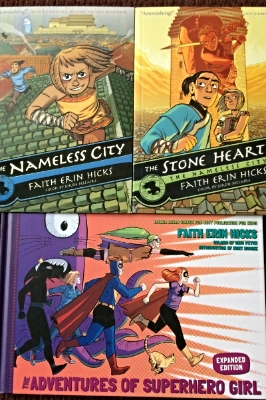Self-publishing graphic novels online: A spotlight on Faith Erin Hicks!
![]()
by Brittany Melia
Faith Erin Hicks is a Canadian graphic novelist with whom I have recently become obsessed. In a story of career progression that is becoming more and more common in today’s digital world, Hicks first gained recognition not through professional work in traditional publishing, but by publishing her graphic novels online and cultivating a fanbase. Her first comic was called Demonology 101 (2004), and, for a while, it was the longest completed graphic novel to be self-published online. Now, Hicks has over fifteen graphic novels that have been traditionally published and is able to make a living drawing and writing comics - she’s even writing a new series of graphic novels as a follow up to the cartoon series Avatar the Last Airbender (also known as the best American animated series of all time as per an anonymous, but totally unbiased source). So … enough said.

The Nameless City, The Stone Heart, and The Adventures of Superhero Girl from my collection
Now, this might seem well and good, but how exactly does a graphic novelist break into commercial publishing by starting out self-publishing online? While there is not one correct answer or definite means of becoming a successful graphic novelist, in Hicks’ case, she managed to transition to a more lucrative form of publishing by sticking to her roots in online comics. For two of her most successful graphic novels Friends With Boys (2012) and Nothing Can Possibly Go Wrong (2013), Hicks and the publishing company she works for, First Second Books, released one page of each comic a day online for free leading up to the physical commercial release in stores (Hicks, 2011; Hicks & Shen, 2012). This meant that fans of Hicks’ original work and platform could experience the same thrill of discussing the book as it was posted, making predictions for future plotlines or speculating about character development. In short, the passion and community that flourish from self-publishing stories sequentially online was used to launch more of Hicks’ works before they were published traditionally. The power of fandom and community are at the core of success when self-publishing online.
Developing relationships with fans is a crucial part of generating excitement about one’s work on the part of the author when it comes to online graphic novels, or any material published online, really. On Hicks’ original website where she first published Demonology 101 she included a page for news updates so fans could keep up with her schedule and progress on the graphic novel, art pages for her own art and fanart alike, and discussion forums where community members could discuss the graphic novel with each other and Hicks. This was all in addition to the page on which she posted the comic! Over time, Hicks eventually began sharing personal stories with her readers such as the instance when her father walked out on her family for a short time (Hicks, 2004). One big family community, a successful online graphic novel makes.
Faith Erin Hicks at the 2012 American Library Association Conference
With the bond that this kind of reading experience creates, it’s a bit shocking that Hicks’ Demonology 101 is no longer available online and that she has no plans to re-upload it (Hicks, 2017). (*whispers* Actually, I'm lying, and you can access most of the pages via The Wayback Machine, although it's a rather time-consuming process to track down all of the pages). While the experience of reading the comic in real-time cannot be recreated today, you’d think that having new fans and readers would still be a positive thing. Hicks has stated on her new website that she believes that eighteen years is enough of a lifespan for an online comic (Hicks, 2017). Does this suggest that online graphic novels have a shelf-life? Is the true joy in reading self-published comics online only in the community it fosters? I have to believe the answer is no. People wouldn’t take the time to write posts about a graphic novel if they weren’t invested in the story and characters regardless of the socializing it might offer. Perhaps this shows that creators and marketers alike are still unsure about how to treat self-published materials online once they’re completed. Whatever the case may be, self-publishing graphic novels online has become a means to not only share one’s work and perhaps break into the traditional publishing business, but also a way to connect readers and authors alike.
References
American Library Association. (2012, June, 25). Artist Alley: A Conversation with Faith Erin Hicks [Video File].
Hicks, Faith Erin. (2004, July 25). So what’s it like, doing an online comic? [Blog post].
Hicks, Faith Erin. (2011-2012). About Friends with Boys. [Blog post].
Hicks, Faith Erin. (2017, November 5). Two questions and two announcements! [Blog post].
Hicks, Faith Erin & Shen, Prudence. (2012, September 24). Page 001. [Blog post].
